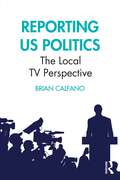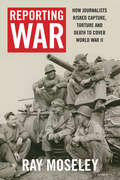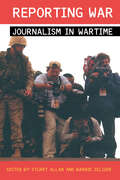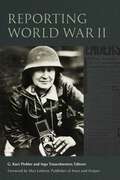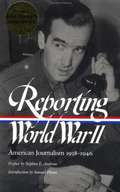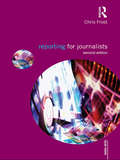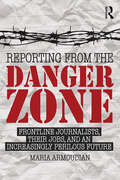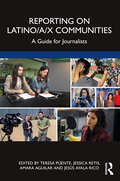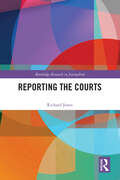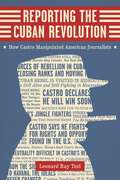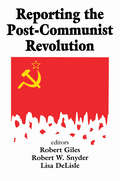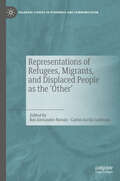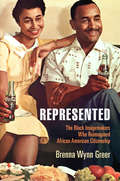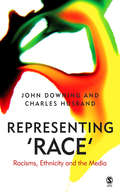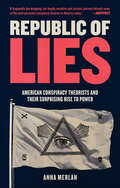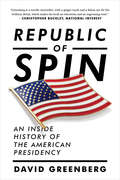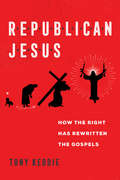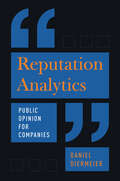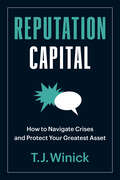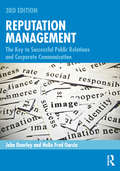- Table View
- List View
Reporting US Politics: The Local TV Perspective
by Brian CalfanoWith a particular focus on the United States, this book offers a practical guide to writing and delivering sound political TV news coverage.Beginning with a historical overview of political reporting, and contextualizing political journalism and local TV news within wider industry issues, this book goes on to offer an essential understanding of the complex decision-making inherent in this critical form of journalism today. In accessible and engaging language, Calfano introduces students to all the basics of local political TV reporting—writing, shooting, editing, and producing—touching on long-form interviewing, political "talkbacks," election coverage, using data, and investigative journalism as a means of uncovering political stories. Readers will learn about working the political beats, from the City Hall to the Statehouse and from policy to budgets, in a way which is both compelling and ethical. A chapter on local, state, and federal government acts as a quick reference primer to the US political landscape. Each chapter includes a series of reflection exercises and ideas for exploring political coverage from the perspectives introduced, and case studies help readers translate what they’ve learned into real-world practice. This book also features a list of quick hacks for political reporters and a political resource list which TV news reporters and producers can go to for sources and government information.This textbook is essential reading for anyone aspiring to become a reporter, producer, or news manager in the United States and will also be of great value to students of Political Journalism, Broadcast Journalism, and Local TV News worldwide.
Reporting War: How Foreign Correspondents Risked Capture, Torture and Death to Cover World War II
by Ray MoseleyThis &“excellent, wonderfully-researched&” chronicle of WWII journalism explores the lives and work of embedded reporters across every theater of war (Chris Ogden, former Time magazine bureau chief in London). Luminary journalists Ed Murrow, Martha Gellhorn, Walter Cronkite, and Clare Hollingworth were among the young reporters who chronicled World War II&’s daily horrors and triumphs for Western readers. In Reporting War, fellow foreign correspondent Ray Moseley mines their writings to create an exhilarating parallel narrative of the war effort in Europe, Pearl Harbor, North Africa, and Japan. This vivid history also explores the lives, methods, and motivations of the courageous journalists who doggedly followed the action and the story, often while embedded in the Allied armies. Moseley&’s sweeping yet intimate history draws on newly unearthed material to offer a comprehensive account of the war. Reporting War sheds much-needed light on an abundance of individual stories and overlooked experiences, including those of women and African-American journalists, which capture the drama as it was lived by reporters on the front lines of history.
Reporting War: Journalism in Wartime (Digital Media And Society Ser.)
by Stuart Allan Barbie ZelizerReporting War explores the social responsibilities of the journalist during times of military conflict. News media treatments of international crises, especially the one underway in Iraq, are increasingly becoming the subject of public controversy, and discussion is urgently needed. Each of this book's contributors challenges familiar assumptions about war reporting from a distinctive perspective. An array of pressing issues associated with conflicts over recent years are identified and critiqued, always with an eye to what they can tell us about improving journalism today. Special attention is devoted to recent changes in journalistic forms and practices, and the ways in which they are shaping the visual culture of war, and issues discussed, amongst many, include: the influence of censorship and propaganda 'us' and 'them' news narratives access to sources '24/7 rolling news' and the 'CNN effect' military jargon (such as 'friendly fire' and 'collateral damage') 'embedded' and 'unilateral' reporters tensions between objectivity and patriotism. The book raises important questions about the very future of journalism during wartime, questions which demand public dialogue and debate, and is essential reading for students taking courses in news and news journalism, as well as for researchers, teachers and practitioners in the field.
Reporting World War II (World War II: The Global, Human, and Ethical Dimension)
by G. Kurt Piehler and Ingo TrauschweizerThis set of essays offers new insights into the journalistic process and the pressures American front-line reporters experienced covering World War II. Transmitting stories through cable or couriers remained expensive and often required the cooperation of foreign governments and the American armed forces. Initially, reporters from a neutral America documented the early victories by Nazi Germany and the Soviet invasion of Finland. Not all journalists strove for objectivity. During her time reporting from Ireland, Helen Kirkpatrick remained a fierce critic of that country’s neutrality. Once the United States joined the fight after the Japanese attack on Pearl Harbor, American journalists supported the struggle against the Axis powers, but this volume will show that reporters, even when members of the army sponsored newspaper, Stars and Stripes were not mere ciphers of the official line.African American reporters Roi Ottley and Ollie Stewart worked to bolster the morale of Black GIs and undermined the institutional racism endemic to the American war effort. Women front-line reporters are given their due in this volume examining the struggles to overcome gender bias by describing triumphs of Thérèse Mabel Bonney, Iris Carpenter, Lee Carson, and Anne Stringer.The line between public relations and journalism could be a fine one as reflected by the U.S. Marine Corps’ creating its own network of Marine correspondents who reported on the Pacific island campaigns and had their work published by American media outlets. Despite the pressures of censorship, the best American reporters strove for accuracy in reporting the facts even when dependent on official communiqués issued by the military. Many wartime reporters, even when covering major turning points, sought to embrace a reporting style that recorded the experiences of average soldiers. Often associated with Ernie Pyle and Bill Mauldin, the embrace of the human-interest story served as one of the enduring legacies of the conflict.Despite the importance of American war reporting in shaping perceptions of the war on the home front as well as shaping the historical narrative of the conflict, this work underscores how there is more to learn. Readers will gain from this work a new appreciation of the contribution of American journalists in writing the first version of history of the global struggle against Nazi Germany, imperial Japan, and fascist Italy.
Reporting World War II: American Journalism 1938-1946
by Samuel Hynes Nancy Caldwell Sorel Anne Matthew Roger J. SpillerHere, for the first time in paperback, the work of more than 50 remarkable reporters has been drawn from original newspaper and magazine reports, radio transcripts, and wartime books to capture the intensity of World War II's unfolding drama.
Reporting for Journalists
by Chris FrostReporting for Journalists explains the key skills needed by the twenty-first century news reporter. From the process of finding a story and tracing sources, to interviewing contacts, gathering information and filing the finished report, it is an essential handbook for students of journalism and a useful guide for working professionals. Reporting for Journalists explores the role of the reporter in the world of modern journalism and emphasises the importance of learning to report across all media – radio, television, online, newspapers and periodicals. Using case studies, and examples of print, online and broadcast news stories, the second edition of Reporting for Journalists includes: information on using wikis, blogs, social networks and online maps finding a story and how to develop ideas researching the story and building the contacts book including crowd sourcing and using chat rooms interactivity with readers and viewers and user generated content making best use of computer aided reporting (CAR), news groups and search engines covering courts, councils and press conferences reporting using video, audio and text preparing reports for broadcasting or publication consideration of ethical practice, and cultural expectations and problems an annotated guide to further reading, a glossary of key terms and a list of journalism websites and organisations.
Reporting from the Danger Zone: Frontline Journalists, Their Jobs, and an Increasingly Perilous Future
by Maria ArmoudianJournalism is a dangerous business when one’s "beat" is a war zone. Armoudian reveals the complications facing frontline journalists who cover warzones, hot spots and other hazardous situations. It compares yesterday’s conflict journalism, which was fraught with its own dangers, with today’s even more perilous situations—in the face of shrinking journalism budgets, greater reliance on freelancers, tracking technologies, and increasingly hostile adversaries. It also contrasts the difficulties of foreign correspondents who navigate alien sources, languages and land, with domestically-situated correspondents who witness their own homelands being torn apart.
Reporting on Latino/a/x Communities: A Guide for Journalists
by Teresa PuenteThis book offers a critical and practical guide for journalists reporting on issues affecting the Latinx community. Reporting on Latino/a/x Communities emphasizes skills and best practices for covering topics such as economics, immigration and gender. The authors share honest stories about challenges Latino/a/x journalists face in newsrooms, including imposter syndrome and lack of representation in news, along with strategies to face and tackle systematic barriers. Stories from leaders in the media industry are also featured, including journalists and media professionals from ABC News, Los Angeles Times, Alt.Latino at NPR, and mitú. Additionally highlighted are experimental and non-traditional new initiatives and outlets leading the future of news media for Latino/a/x audiences. This book is an invaluable guide for any student or journalist interested or involved in the news media and questions of Latino/a/x representation.
Reporting on Race in a Digital Era
by Carolyn NielsenThis book explores U.S. news media’s 21st century reckoning with race, from the election of President Barack Obama, through the birth and growth of the Black Lives Matter movement, to the tense weeks after a white police officer killed an unarmed African American teenager in Ferguson, Missouri. While legacy newsrooms struggled to interpret complex events, a diverse group of digital storytellers used emerging technologies. Veteran journalist and media scholar Carolyn Nielsen examines how the first two decades of this century produced new models for journalists to explore the complexity of racism, amplify the voices of lived experience, and understand their audiences. Using critical analysis of news coverage and interviews with reporters who cover racial issues, the book shows how new models of journalism break with legacy journalism’s conceptions of objectivity, expertise, and news judgment to provide deeper understanding of systems of power.
Reporting the Courts (Routledge Research in Journalism)
by Richard JonesThis book makes a critical intervention into debates about journalism and the crisis in local news. Interrogating the history and current practice of court coverage in the UK, the author argues for its importance as a central feature of both open justice and public interest reporting.The book challenges narratives of a decline in the perceived quality of local media. Yet it also highlights a reliance on major local press companies facing acute financial challenges, meaning court reporting faces a potentially precarious future. The book critically examines coverage of the courts in the context of financial crises, which have diminished both newspapers and the criminal justice system. How the norms of court journalism emerged and evolved are put under scrutiny, and the book then considers how court reporting is practiced today, including the use of cameras and social media as well as remote hearings during and since the pandemic. The author takes us inside a major murder trial and explores why court reporting remains worth preserving and enhancing.Offering recommendations which could help to maintain and extend coverage of the courts, this volume will interest students and scholars of journalism, mass communication, media studies, media law and communication studies.
Reporting the Cuban Revolution: How Castro Manipulated American Journalists (Media and Public Affairs)
by Leonard Ray TeelReporting the Cuban Revolution reveals the untold story of thirteen American journalists in Cuba whose stories about Fidel Castro's revolution changed the way Americans viewed the conflict and altered U.S. foreign policy in Castro's favor. Between 1956 and 1959, the thirteen correspondents worked underground in Cuba, evading the repressive censorship of Fulgencio Batista's dictatorship in order to report on the rebellion led by Fidel Castro. The journalists' stories appeared in major newspapers, magazines, and national television and radio, influencing Congress to abruptly cut off shipments of arms to Batista in 1958. Castro was so appreciative of the journalists' efforts to publicize his rebellion that on his first visit to the United States as premier of Cuba, he invited the reporters to a private reception at the Cuban Embassy in Washington, where he presented them with engraved gold medals. While the medals revealed Castro's perception of the correspondents as like-minded partisans, the journalists themselves had no such intentions. Some had journeyed to Cuba in pursuit of scoops that could rejuvenate or jump-start their careers; others sought to promote press freedom in Latin America; still others were simply carrying out assignments from their editors. Bringing to light the disparate motives and experiences of the thirteen journalists who reported on this crucial period in Cuba's history, Reporting the Cuban Revolution is both a masterwork of narrative nonfiction and a deft analysis of the tension between propaganda and objectivity in the work of American foreign correspondents.
Reporting the Post-communist Revolution
by Robert SnyderThe events of 1989 were the material of great reporting. They also revealed the power of journalism. Long before people in Central and Eastern Europe liberated themselves, they discovered democratic freedom, putting to print their own ideas and chronicling events of the day. Indeed, long before they had democracies in law, they had imagined them on paper.In the Solidarity network that produced books and leaflets and news bulletins, in the essays of Václav Havel, in the samizdat publishing house in Budapest that used a portable printing machine, Eastern Europeans demonstrated the organic link between journalism and self-government. They showed how journalism nurtures the imagination, dialogue, and honesty that are basic to democratic life.If history had ended in 1989, there would be cause for easy optimism. The changes that swept Central and Eastern Europe passed with relatively little bloodshed. But agonies of the former Yugoslavia, convulsions of the former Soviet Union, and enduring battles with censors and would-be censors bedevil emerging democracies. Not only does much remain for journalists to cover in Central and Eastern Europe, in some places there the fate of journalism is still an open question. For all these reasons, Reporting the Fall of European Communism explores, not only the events of 1989, but new stories that have emerged in Central and Eastern Europe over the past decade. This volume will be of interest to media professionals, academics and others with an interest in the power of journalism.
Representations of Refugees, Migrants, and Displaced People as the ‘Other’ (Palgrave Studies in Otherness and Communication)
by Rui Alexandre Novais Carlos Arcila CalderónThis book explores how 21st-century media-based discourses on migrants, refugees, and displaced people both reinforce and reconfigure existing negative stereotypes about these groups as 'other.' It is particularly pertinent considering the increasingly polarized world context and the evolving communication ecosystem with new media as privileged platforms for exclusionary narratives toward the ‘outgroups’ of migrants, refugees, and displaced people. The book's contributions encompass various methodologies and disciplines within communication studies, including qualitative analyses of media representations and quantitative research on public opinion. Unlike much of the existing English-language scholarship on these marginalized communities, this book de-centers North America and the UK to offer a global perspective focusing on regions such as continental and eastern Europe, the Middle East and Persian Gulf, India, China, Turkey, Russia, and Scandinavia.
Represented: The Black Imagemakers Who Reimagined African American Citizenship (American Business, Politics, and Society)
by Brenna Wynn GreerIn 1948, Moss Kendrix, a former New Deal public relations officer, founded a highly successful, Washington, D.C.-based public relations firm, the flagship client of which was the Coca-Cola Company. As the first black pitchman for Coca-Cola, Kendrix found his way into the rarefied world of white corporate America. His personal phone book also included the names of countless black celebrities, such as bandleader Duke Ellington, singer-actress Pearl Bailey, and boxer Joe Louis, with whom he had built relationships in the course of developing marketing campaigns for his numerous federal and corporate clients. Kendrix, along with Ebony publisher John H. Johnson and Life photographer Gordon Parks, recognized that, in the image-saturated world of postwar America, media in all its forms held greater significance for defining American citizenship than ever before. For these imagemakers, the visual representation of African Americans as good citizens was good business.In Represented, Brenna Wynn Greer explores how black entrepreneurs produced magazines, photographs, and advertising that forged a close association between blackness and Americanness. In particular, they popularized conceptions of African Americans as enthusiastic consumers, a status essential to postwar citizenship claims. But their media creations were complicated: subject to marketplace dictates, they often relied on gender, class, and family stereotypes. Demand for such representations came not only from corporate and government clients to fuel mass consumerism and attract support for national efforts, such as the fight against fascism, but also from African Americans who sought depictions of blackness to counter racist ideas that undermined their rights and their national belonging as citizens.The story of how black capitalists made the market work for racial progress on their way to making money reminds us that the path to civil rights involved commercial endeavors as well as social and political activism.
Representing Death in the News
by Folker HanuschThis new study maps and synthesizes existing research on the ways in which journalism deals with death. Folker Hanusch provides a historical overview of death in the news, looks at the conditions of production, content and reception, and also analyzes emerging trends in the representation of death online.
Representing Race: Racisms, Ethnicity and the Media
by John D. Downing Charles HusbandWell-informed, thoughtful and transnational in its perspectives, Downing and Husband¦s work is likely to become the key text in the field. The book is essential reading for anyone interested in the politics of race and representation - Professor Daya K. Thussu, University of Westminster, UK The Media play a diverse and significant role in the practical expression of racism and in the everyday politics of ethnicity. Written by two veterans of research on media and 'race', this book offers a fresh comparative analyses of the issues and sets out the key agendas for future study. Representing 'Race': racisms, ethnicities and media - Introduces and evaluates key conceptual issues - Provides a conceptual framework for understanding the role of the media - Addresses a number of pressing political concerns including 'racial'justice and the drift to the Right - Includes a wide range of contemporary examples from Britain, the USA, Europe, Australia. - Analyzes the growth of indigenous people's media - Compares media representations of 'race', 'religion', 'tribe', and 'nationality' - Assesses current strategies for reforming professional media practice in this sphere. Drawing on years of research, this book provides both a major intervention in the debate, as well as a comprehensive introduction to the area. As such, it will be required reading for anyone interested in 'race', representation and the media.
Republic of Lies: American Conspiracy Theorists and Their Surprising Rise to Power
by Anna Merlan“[An] engrossing assessment of the profitable mainstreaming of conspiracy mongering in civic and political life . . . A lucid look at a slippery topic.” —Kirkus ReviewsAmerican society has always been fertile ground for conspiracy theories, but with the election of Donald Trump, previously outlandish ideas suddenly attained legitimacy. Trump himself is a conspiracy enthusiast: From his claim that global warming is a Chinese hoax to the accusations of “fake news,” he has fanned the flames of suspicion.But it was not one man alone who gave these ideas increased power. Republic of Lies looks beyond the caricatures of conspiracy theorists to explain their tenacity. Without lending the theories validity, Anna Merlan gives a nuanced, sympathetic account of the people behind them, across the political spectrum, and the circumstances that helped them take hold. The lack of a social safety net, inadequate education, bitter culture wars, and years of economic insecurity have created large groups of people who feel forgotten by their government and even besieged by it. Our contemporary conditions are a perfect petri dish for conspiracy movements: a durable, permanent, elastic climate of alienation and resentment. All the while, an army of politicians and media figures have peddled fear to serve their own ends.Bringing together penetrating historical analysis and gripping on-the-ground reporting, Republic of Lies transforms our understanding of American paranoia.“A captivating book that illuminates the landscape of conspiracy theories and what they might say about society as a whole.” —New York Magazine
Republic of Spin: An Inside History of the American Presidency
by David Greenberg<P>In Republic of Spin—a vibrant history covering more than one hundred years of politics—presidential historian David Greenberg recounts the rise of the White House spin machine, from Teddy Roosevelt to Barack Obama. His sweeping, startling narrative takes us behind the scenes to see how the tools and techniques of image making and message craft work. We meet Woodrow Wilson convening the first White House press conference, Franklin Roosevelt huddling with his private pollsters, Ronald Reagan’s aides crafting his nightly news sound bites, and George W. Bush staging his “Mission Accomplished” photo-op. We meet, too, the backstage visionaries who pioneered new ways of gauging public opinion and mastering the media—figures like George Cortelyou, TR’s brilliantly efficient press manager; 1920s ad whiz Bruce Barton; Robert Montgomery, Dwight Eisenhower’s canny TV coach; and of course the key spinmeisters of our own times, from Roger Ailes to David Axelrod. <P>Greenberg also examines the profound debates Americans have waged over the effect of spin on our politics. Does spin help our leaders manipulate the citizenry? Or does it allow them to engage us more fully in the democratic project? Exploring the ideas of the century’s most incisive political critics, from Walter Lippmann and H. L. Mencken to Hannah Arendt and Stephen Colbert, Republic of Spin illuminates both the power of spin and its limitations—its capacity not only to mislead but also to lead.
Republican Jesus: How the Right Has Rewritten the Gospels
by Tony KeddieThe complete guide to debunking right-wing misinterpretations of the Bible—from economics and immigration to gender and sexuality.Jesus loves borders, guns, unborn babies, and economic prosperity and hates homosexuality, taxes, welfare, and universal healthcare—or so say many Republican politicians, pundits, and preachers. Through outrageous misreadings of the New Testament gospels that started almost a century ago, conservative influencers have conjured a version of Jesus who speaks to their fears, desires, and resentments. In Republican Jesus, Tony Keddie explains not only where this right-wing Christ came from and what he stands for but also why this version of Jesus is a fraud. By restoring Republicans’ cherry-picked gospel texts to their original literary and historical contexts, Keddie dismantles the biblical basis for Republican positions on hot-button issues like Big Government, taxation, abortion, immigration, and climate change. At the same time, he introduces readers to an ancient Jesus whose life experiences and ethics were totally unlike those of modern Americans, conservatives and liberals alike.
Reputation Analytics: Public Opinion for Companies
by Daniel DiermeierA scientific approach to corporate reputation from the field’s leading scholar. Public opinion is a core factor of any organization’s success—and sometimes its failings. Whether through crisis, mismanagement, or sudden shifts in public sensibility, an organization can run afoul in the span of a Tweet. In Reputation Analytics, Daniel Diermeier offers the first rigorous analytical framework for understanding and managing corporate reputation and public perception. Drawing on his expertise as a political scientist and management scholar, Diermeier incorporates lessons from game theory, psychology, and text analytics to create a methodology that has immediate application in both scholarship and practice. A milestone work from one of social science’s most eminent scholars, Reputation Analytics unveils an advanced understanding of an elusive topic, resulting in an essential guide for academics and readers across industries.
Reputation Analytics: Public Opinion for Companies
by Daniel DiermeierA scientific approach to corporate reputation from the field’s leading scholar. Public opinion is a core factor of any organization’s success—and sometimes its failings. Whether through crisis, mismanagement, or sudden shifts in public sensibility, an organization can run afoul in the span of a Tweet. In Reputation Analytics, Daniel Diermeier offers the first rigorous analytical framework for understanding and managing corporate reputation and public perception. Drawing on his expertise as a political scientist and management scholar, Diermeier incorporates lessons from game theory, psychology, and text analytics to create a methodology that has immediate application in both scholarship and practice. A milestone work from one of social science’s most eminent scholars, Reputation Analytics unveils an advanced understanding of an elusive topic, resulting in an essential guide for academics and readers across industries.
Reputation Capital: How to Navigate Crises and Protect your Greatest Asset
by T.J. WinickA longtime broadcast journalist, ABC News correspondent, and business communication strategist shows how you can craft an honest and authentic response to any scandal, rather than try to deny it, and ultimately bolster your brand.In twenty years as a television reporter, T. J. Winick covered many scandals, including the British Petroleum oil spill, the Pennsylvania State University football scandal, the Catholic priest molestation scandal, and the Toyota recall of 20092010. The biggest mistake he's seen organizations make in their crisis communication is to try to make it go away by refusing to apologize, declining to comment, or going on the attack-anything to deflect attention. Instead, Winick argues for communicating ethically, with transparency, honesty, authenticity, and empathy. Handled correctly, the way you address an egregious violation of your standards can increase your reputation capital. It can remind people of what those standards are and how strongly you believe in them. Drawing on his intimate insider knowledge of how the media works, Winick addresses every aspect of how to respond to a scandal. He includes the Ten Crisis Commandments-universal dos and don'ts. And he gives practical advice on who you should talk to and when, who should do the talking, how to form a crisis communication team, what tone you should strike in your message, how to work with the media, and much more.
Reputation Management für CEOs: Wie Top-Manager ihren guten Ruf sichern können (essentials)
by Wolfgang GriepentrogDieses essential hilft Top-Managern und Kommunikationsverantwortlichen, die Manager-Reputation systematisch und konsequent zu sichern und weiterzuentwickeln. Ziel dieses Praxisleitfadens ist es, personenbezogene Reputationsfehler oder Widersprüche im Auftritt zu vermeiden, dadurch Schäden für das Unternehmen abzuwenden und stattdessen den guten Ruf des Spitzenpersonals als Basis für geschäftliche und unternehmerische Erfolge zu festigen. Der Autor beschreibt die einzelnen Bausteine und die systematischen Arbeitsschritte des Reputationsmanagements. Er macht die Anforderungen deutlich und erklärt das Zusammenspiel zwischen Top-Managern als „Hauptdarstellern“ und Kommunikationsprofis als „Regieführern“ des Auftritts.
Reputation Management: The Future Of Corporate Communications and Public Relations (PRCA Practice Guides)
by Tony Langham PrcaA good reputation is vital to success in business and in life. Organizations with the best reputations outperform rivals in a myriad of tangible ways; they recruit higher quality staff, succeed with smaller marketing budgets, and exert greater influence over Governments. Although in the long term reputation is based on reality and behavior, short term examples of organizations and individuals building unfair advantage can be seen all around us. Despite this, reputation remains an often misunderstood and neglected asset. <p><p>In Reputation Management: The Future of Corporate Communications and Public Relations, Tony Langham argues that reputation management is the future incarnation of public relations and corporate communications. Featuring specially commissioned essays, as well as exclusive interviews with leading CEOs, influencers and celebrities, the book covers issues as diverse as fake news, AI, James Bond, cyber security and internet bullying. Also included are contributions from thirty-nine of the world’s leading reputation managers who exclusively reveal the time they made the most difference to an organization's reputation.
Reputation Management: The Key to Successful Public Relations and Corporate Communication
by John Doorley Helio Fred GarciaReputation Management is a how-to guide for students and professionals, as well as CEOs and other business leaders. It rests on the premise that reputation can be measured, monitored, and managed. Organized by corporate communication units including media relations, employee communication, government relations, and investor relations, the book provides a field-tested guide to corporate reputation problems such as leaked memos, unfair treatment by the press, and negative rumors, and focuses on practical solutions. Each chapter is fleshed out with the real-world experience of the authors and contributors, who come from a wide range of professional corporate communication backgrounds. Updates to the third edition include: Global content has been incorporated and expanded throughout the book, rather than being restricted to only one chapter. Opening vignettes, examples, and case studies have been updated in each chapter. Additional case studies and examples with an international focus have been added.
